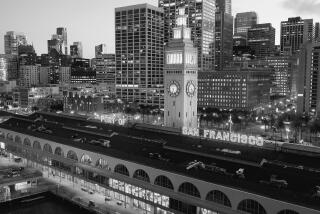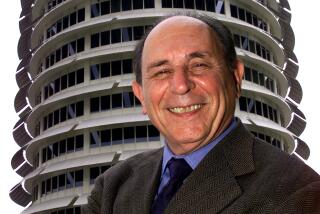Capitalism Tops Democracy in Tower’s Design
The new design for the Freedom Tower at the site of the former World Trade Center is exactly what the public should expect from a process in which commercial interests push the public interest to the background: a slightly better-than-average design that lacks imaginative power.
Designed by David M. Childs of Skidmore, Owings & Merrill, the tower design calls for 70 stories of commercial space topped by a latticework crown housing an observation deck. A slender spire extends up from here, reaching a height of 1,776 feet -- an obvious effort to imbue the tower with historical meaning.
What is most striking about the design, however, is its lack of originality. Much has been made of the fact that Childs’ design was developed without the participation of Daniel Libeskind, the architect selected earlier this year as the master planner for ground zero. Childs has preserved many components of the Libeskind design -- but has watered them down to the point that they have lost much of their punch.
The diluted design raises questions as to what kind of architectural standards we should expect for a project so weighted with meaning. Architecture -- especially at this scale -- is a political as well as an aesthetic process. The issue is which takes precedence.
The new tower’s 1,776-foot height comes directly from the Libeskind proposal. The spire, set off to one side of the building’s core, also comes from Libeskind and is meant to echo the raised arm of the nearby Statue of Liberty. The empty frame that encloses the viewing deck is vaguely modeled on the earlier design’s memorial gardens, which were to be suspended within the tower’s upper floors. Of these elements, the height is the most arbitrary and pointless -- an attempt to pander to patriotic feelings that has little visual meaning.
Childs’ proposal also draws on other tower designs that have made their way into the architectural consciousness in recent times. Its ephemeral upper levels evoke Jean Nouvel’s 1989 design for an “endless tower,” whose solid base appears to dissolve as it rises into the sky. Nouvel’s design received international acclaim but was never built. The Freedom Tower’s lattice-like exterior frame recalls the structure of the original World Trade Center towers.
Originality is not a prerequisite for a firm’s success. During its heyday in the 1950s, Skidmore, Owings & Merrill built its reputation by taking well-worn Modernist formulas and using them to design competent, even graceful buildings that were less important for their innovation than for bringing Modernism into the mainstream.
One of the best of these is Manhattan’s 1952 Lever House, an office building designed by the firm’s noted chief designer, Gordon Bunshaft. The building’s sleek glass and metal exterior make it a landmark of American corporate architecture.
The Freedom Tower strives to live up to those earlier standards. But it lacks the slender elegance of Libeskind’s proposal. At the same time, it is a step up from an earlier design that Childs completed for the site’s leaseholder, Larry Silverstein, which was never made public. It is of a higher quality than Skidmore, Owings & Merrill’s entry for the 2002 master plan competition. (That scheme was rejected by the Lower Manhattan Development Corp. after a lukewarm public reception.)
Since the twin towers were destroyed by terrorist attacks more than two years ago, politicians, architects and planners have stressed that the symbolic importance of the site demanded a level of design above the norm. They have also paid a great deal of lip service to the public process, repeatedly claiming that the design would be shaped to reflect the nature of the tragedy.
In truth, ground zero is primarily about real estate. During the last few months, Silverstein has reasserted his control over much of the site’s commercial space. Meanwhile, Libeskind increasingly appears to have become a pawn in a byzantine political process. His reputation as a serious, uncompromising designer was cemented in Germany in the 1990s, where his Jewish Museum in Berlin has been rightfully celebrated as a masterpiece of contemporary design. Yet in New York, his function, in part, has been to lend an air of legitimacy to a process that is unlikely to produce the highest level of design.
It is in that sense that the tower design should be read with skepticism. The second-rate quality speaks to the limits of the democratic process when it comes face to face with commerce. As such, it underscores the limits our culture places on the imaginative process, even under circumstances when the public welfare should rule.
More to Read
The biggest entertainment stories
Get our big stories about Hollywood, film, television, music, arts, culture and more right in your inbox as soon as they publish.
You may occasionally receive promotional content from the Los Angeles Times.










